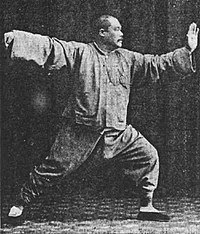T'ai chi ch'uan
From Wikipedia, the free encyclopedia
"Taiji" redirects here. For the philosophical concept, see Taiji (philosophy). For other uses, see Taiji (disambiguation).
See also: Taichi (name)
 | |
|---|---|
| The lower dantian in taijiquan: yin and yang rotate, while the core reverts to stillness (wuji) | |
 Yang Chengfu in a posture from the Yang-style t'ai chi ch'uan solo form known as Single Whip c. 1931 | |
| Also known as | Taijizhang[1]; t'ai chi; taiji |
| Focus | Hybrid |
| Hardness | Forms competition, Light contact (pushing hands, no strikes), Full contact (strikes, kicks, throws, etc.) |
| Country of origin | China |
| Creator | Said to be Zhang Sanfeng |
| Famous practitioners | Chen Wangting, Chen Changxing, Chen Fake, Yang Lu-ch'an, Yang Chengfu, Wu Ch'uan-yu, Wu Chien-ch'uan, Wu Yu-hsiang, Sun Lu-t'ang, Wang Pei-sheng |
| Olympic sport | Demonstration only |
| T'ai chi ch'uan / Taijiquan | |||
|---|---|---|---|
| Traditional Chinese | 太極拳 | ||
| Simplified Chinese | 太极拳 | ||
| Literal meaning | supreme ultimate fist | ||
| |||
| Taijizhang | |||
| Simplified Chinese | 太极掌 | ||
| Literal meaning | supreme ultimate palm | ||
| |||
| Part of a series on |
| Chinese martial arts |
|---|
 |
| List of Chinese martial arts |
Today, t'ai chi ch'uan has spread worldwide. Most modern styles of t'ai chi ch'uan trace their development to at least one of the five traditional schools: Chen, Yang, Wu (Hao), Wu, and Sun.
No comments:
Post a Comment